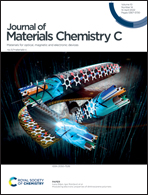Ligand design and nuclearity variation towards dual emissive Pt(ii) complexes for singlet oxygen generation, dual channel bioimaging, and theranostics†
Abstract
Organic ligands comprising thiophene ring(s) afford complexes of transition metals, such as Pt(II) and Ir(III), with photoluminescence readily tunable via ligand modifications. In this work we demonstrate the targeted design of a N^C-C^N type ditopic ligand with a central thiophene ring as the cyclometalating core and variation of the nuclearity of the complex to fine-tune the photophysical properties of the material. The mononuclear complex Pt-1 shows red T1 → S0 phosphorescence with the emission maximum at λ = 660 nm. The dinuclear complex Pt-2 shows near infrared (NIR) T1 → S0 phosphorescence peaking at λ = 710 nm. In both cases the phosphorescence is quenched by molecular oxygen generating singlet oxygen molecules with high efficiencies of ϕΔ ≈ 83% (Pt-1) and ϕΔ≈ 70% (Pt-2, respectively) in air-equilibrated CH2Cl2 solutions under ambient conditions. The red phosphorescence of Pt-1 is accompanied by green S1 → S0 fluorescence with the maximum at λ = 495 nm. This makes Pt-1 a dual emissive material with two emissions stemming from a single chromophore moiety. Transient absorption studies revealed a relatively low rate of ISC from the S1 state to the triplet manifold with a time constant τ(ISC) of about 4 ps. The slow ISC in Pt-1 is rationalized by a specific electronic structure with a relatively large energy gap ΔE(S1 → T1) ≈ 0.63 eV and the higher triplet state T2 being higher in energy than the singlet state S1. In dinuclear Pt-2, state T2 lies below S1 opening fast T2 → S1 ISC paths with a time constant τ of only ≈ 0.13 ps. The unique dual emission of Pt-1 was beneficial for its imaging in HeLa cells as it enabled switching between green fluorescence and red phosphorescence channels of detection in the time-span of the single confocal luminescence microscopy experiment. Pt-1 represents a prototype of new theranostic agents combining cytotoxic activity with a unique dual wavelength mode of detection.



 Please wait while we load your content...
Please wait while we load your content...